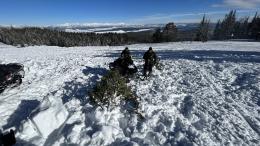Good morning. This is Doug Chabot with the Gallatin National Forest Avalanche Forecast on Thursday, January 5th at 6:45 a.m. This information is sponsored by Spark R&D and Uphill Pursuits. This forecast does not apply to operating ski areas.
This morning temperatures are in the teens F with SW-W wind blowing 10-20 mph. Yesterday, an inch of snow fell in West Yellowstone. Today will be mostly cloudy with SW wind blowing 20 mph. This afternoon snowfall is expected to start in the southern ranges and by morning the mountains around West Yellowstone and Cooke City will have 2” and a trace to 1” falling everywhere else.
Throughout our advisory area we have weak layers buried in the snowpack. The most prominent one is a thick layer of sugary facets near the ground. Yesterday, as Ian and I postholed to our pit site in Taylor Fork we kept punching through the almost supportable slab. Our jarring steps let us know, even without digging, that airy facets were underlying a slab of denser snow. This poor snow structure is widespread and concerning. Some snowpacks are thicker than others and some are supportable, but there’s no getting around this bad structure. As days pass without new snow the mountains trend towards stability as seen by increasing test scores and a decrease in avalanche activity. But it is unwise and dangerous to think that all slopes are safe, because they are not. Ian and I saw a small avalanche in Cabin Creek as evidence of instability (video). And let’s not forget that a young man died in an avalanche in Cooke City on Saturday (video and details). In the last couple of days we have gotten observations of stability, and even found it ourselves, but we also find slopes that are scary and unstable causing us to retreat, like I did on Saddle Peak on Tuesday (video) and skiers did in Flanders Creek yesterday.
We handle these lurking instabilities a few different ways. Signs of recent avalanche activity, even small slides, are Mother Nature's siren to not be cavalier in our travels. This is especially helpful for sledders who ride many slopes on many aspects. Digging a pit and performing stability tests can turn us around when we get poor scores. And lastly, we should seek a heightened awareness of what is under our feet. Many avalanches were triggered from thinner areas on a slope where a skier or sledder’s weight broke the weak layer and caused an avalanche. These thin zones are scary spots because we don’t always know where they are, but a good guess is near ridgelines, rock outcroppings, or edges of gullies. Only exposing one person at a time on a slope and having everyone carry the triad of avalanche safety gear (beacon, shovel, probe) can stack the deck in our favor if things go wrong.
For today, since avalanches are possible, the avalanche danger is rated MODERATE on all slopes in our forecast area.
Please share avalanche, snowpack or weather observations via our website, email (mtavalanche@gmail.com), phone (406-587-6984), or Instagram (#gnfacobs).
Throughout our advisory area we have weak layers buried in the snowpack. The most prominent one is a thick layer of sugary facets near the ground. As days pass without new snow the snowpack slowly trends towards stability as seen by increasing test scores and a decrease in avalanche activity. But it is unwise and dangerous to think that all slopes are safe, because they are not. Signs of recent avalanche activity, even small slides, are Mother Nature's siren to not be cavalier in our travels. Only exposing one person at a time on a slope and having everyone carry the triad of avalanche safety gear (beacon, shovel, probe) can stack the deck in our favor if things go wrong.
Upcoming Avalanche Education and Events
Our education calendar is full of awareness lectures and field courses. Check it out: Events and Education Calendar.
Every Saturday, 10 a.m. - 2:00 p.m. Avalanche Rescue Training, drop in for any amount of time. Round Lake Warming Hut, Cooke City. Free.
Loss in the Outdoors, is a support group for those who have been affected by grief and loss related to outdoor pursuits. Check out the link for more information.
The triad of avalanche safety gear should be carried at all times in the backcountry: a beacon, shovel and probe. Every time, every day, always. We can supplement these three with other safety equipment, which is not a bad idea. A helmet, airbag, Avalung, chest plates, etc. are great additions to our protective arsenal, but they are not a replacement for a beacon, shovel and probe.



